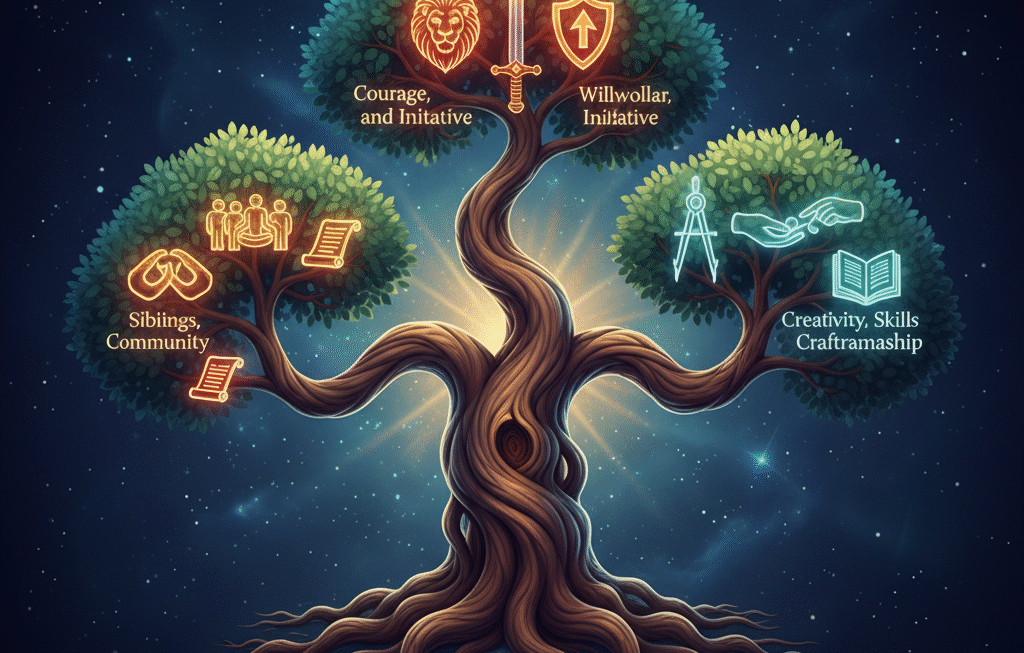What’s the astrological secret behind enduring wealth and financial ease? While the main birth chart (Rasi D1) outlines the broad potential for prosperity through Dhana Yogas, a deeper layer of analysis is required to understand the nature, quality, and ease with which wealth might manifest. In the sophisticated system of Vedic astrology (Jyotish), this crucial insight is primarily revealed through a specific divisional chart: the Hora Chart, or D2. Understanding the hora chart d2 is essential for refining financial predictions and gaining a nuanced perspective on one’s capacity for accumulating and managing resources. This guide introduces the vital D2 chart vedic astrology uses, explaining its significance in assessing financial well-being.
Astrological Yogas & Vargas: Beyond the Surface Promise
Before focusing on the D2 chart, let’s briefly recall the context. The Rasi chart (D1) shows the foundational life map, including planetary yogas or combinations in astrology that indicate potential outcomes like wealth (Dhana Yogas). However, the Divisional Charts (Vargas) provide the necessary depth to interpret these promises accurately. They reveal the underlying quality and operational strength of planets concerning specific life areas. While the Navamsa (D9) is crucial for overall quality and marriage, the Hora (D2) holds the specific key to understanding wealth.
What is the Hora Chart (D2)? Focusing the Lens on Finances
(Opinion): The Hora Chart (D2) is a fundamental Varga chart in Vedic astrology, specifically used to analyze an individual’s potential for acquiring wealth, managing financial resources, and understanding the intrinsic nature of their prosperity. It acts as a crucial filter, refining the broad financial promises seen in the Rasi chart (D1) to reveal the subtle energetic quality governing one’s relationship with money.
(Reason): Why is this simple division so significant for hora wealth analysis? The Hora chart is created by dividing each 30-degree zodiac sign into two equal halves (‘Horas’) of 15 degrees each. Crucially, these halves are assigned lordship based on the polarity associated with the Sun and the Moon.
One Hora in each sign is designated as the Sun’s Hora (representing masculine, assertive, initiating energy related to wealth – earning through effort, status, leadership), and the other is the Moon’s Hora (representing feminine, receptive, nurturing energy related to wealth – accumulation, preservation, easier gains, liquid assets). A planet’s precise degree position in the Rasi chart determines whether it falls into the Sun’s Hora or the Moon’s Hora for that sign. Analyzing the distribution of planets across these two Horas in the D2 chart reveals the underlying energetic style and quality of the individual’s financial potential. It shows how wealth is likely generated and managed on a subtle level.
(Example): Consider someone with strong Dhana Yogas in their Rasi chart. If the key wealth-giving planets (like Jupiter, Venus, or the lords of the 2nd and 11th houses) predominantly fall into the Moon’s Hora in the D2 chart, it suggests that wealth may accumulate more easily, perhaps through family support, investments, or fields related to nurturing or the public.
The wealth might be more liquid or related to comforts. Conversely, if these same planets fall predominantly into the Sun’s Hora, it indicates wealth is more likely generated through personal effort, leadership, authority, status, or fields requiring assertion and initiative. Malefic planets placed in unfavorable Horas can indicate struggles, losses, or unethical means of acquiring wealth, even if the Rasi chart promises abundance.
(Opinion/Restatement): Therefore, the hora chart d2 is an indispensable tool for nuanced financial astrology. It moves beyond the potential for wealth shown in the D1 to reveal the quality, source, and ease of manifestation, making it the essential d2 money chart for refining predictions.

Hora Analysis: Calculation and Key Interpretive Principles
(Pattern Spotting): How is the Hora chart constructed, and how do we begin the hora analysis? The calculation is relatively straightforward compared to other Vargas.
The Calculation Rule:
The rulership of the two Horas (0-15 degrees and 15-30 degrees) depends on whether the zodiac sign is Odd or Even:
- Odd Signs (Aries, Gemini, Leo, Libra, Sagittarius, Aquarius):
- The first 15 degrees (0°00′ to 15°00′) belong to the Sun’s Hora.
- The second 15 degrees (15°00′ to 30°00′) belong to the Moon’s Hora.
- Even Signs (Taurus, Cancer, Virgo, Scorpio, Capricorn, Pisces):
- The first 15 degrees (0°00′ to 15°00′) belong to the Moon’s Hora.
- The second 15 degrees (15°00′ to 30°00′) belong to the Sun’s Hora.
How to Interpret Planetary Placements:
Astrology software typically generates the D2 chart, often simplifying it by placing all planets falling in the Sun’s Hora into the sign Leo, and all planets falling in the Moon’s Hora into the sign Cancer (as per Parashari method). However, the core analysis focuses on which Hora (Sun’s or Moon’s) the key planets occupy:
- Benefics (Jupiter, Venus, Waxing Moon, unafflicted Mercury):
- In Moon’s Hora: Generally considered very auspicious. Indicates wealth acquired relatively easily, steady accumulation, enjoyment of comforts, prosperity through gentle means, good fortune with liquid assets or family wealth. Suggests a nurturing and preserving attitude towards money.
- In Sun’s Hora: Also indicates wealth, but suggests it is earned through status, authority, leadership, self-effort, speculation, or fields associated with the Sun (government, high positions). Wealth may be more related to power and recognition.
- In Moon’s Hora: Generally considered very auspicious. Indicates wealth acquired relatively easily, steady accumulation, enjoyment of comforts, prosperity through gentle means, good fortune with liquid assets or family wealth. Suggests a nurturing and preserving attitude towards money.
- Malefics (Saturn, Mars, Sun, waning Moon, afflicted Mercury, Rahu/Ketu):
- In Sun’s Hora: These planets function relatively better here. Wealth may be earned through hard work, technical fields, assertion, discipline, or even unethical means if heavily afflicted. It suggests effort and struggle are often involved in acquisition. The Sun itself performs well here.
- In Moon’s Hora: Malefics generally struggle in the Moon’s Hora. This placement can indicate difficulty in accumulating wealth, losses, expenses, conflict over resources, or wealth acquired through problematic means. It suggests instability or lack of comfort regarding finances.
- In Sun’s Hora: These planets function relatively better here. Wealth may be earned through hard work, technical fields, assertion, discipline, or even unethical means if heavily afflicted. It suggests effort and struggle are often involved in acquisition. The Sun itself performs well here.
- Lords of Wealth Houses (2nd & 11th): Note which Hora the lords of the 2nd (accumulation) and 11th (gains) fall into. This strongly indicates the primary style of wealth generation and accumulation. Both in Moon’s Hora suggests easier, perhaps inherited or passively accumulated wealth. Both in Sun’s Hora suggests wealth through ambition and effort. A mix indicates both pathways operating.
- Lagna Lord: The Hora placement of the Lagna Lord shows the native’s fundamental approach and effort regarding finances.
- Jupiter (Dhana Karaka): Jupiter’s placement in the D2 is very important. In Moon’s Hora, it’s excellent for overall abundance and ease. In Sun’s Hora, it indicates wealth through wisdom applied in positions of authority or teaching.
D2 Money Chart: What the Hora Reveals
(Value): Summarizing the key insights gained from the d2 money chart:
- Source and Style of Wealth: Is wealth primarily earned through assertive action and status (Sun’s Hora dominant) or accumulated more gently, steadily, or passively (Moon’s Hora dominant)?
- Ease of Acquisition: Planets (especially benefics) predominantly in Moon’s Hora often suggest greater ease and less struggle compared to those in Sun’s Hora, which implies effort is required.
- Nature of Assets: Sun’s Hora can relate more to fixed or status-related assets, while Moon’s Hora may relate more to liquid assets, comforts, and consumables.
- Potential for Struggle: Malefics placed in unfavorable Horas (especially Moon’s Hora for most malefics) highlight potential difficulties, losses, or unethical dimensions related to finances.
- Overall Financial Temperament: The balance of planets between the two Horas provides a nuanced picture of the individual’s core relationship with earning, spending, and saving.
Mythbusting: Limitations and Context for Hora Analysis
(Engagement): While the hora chart d2 provides invaluable financial insights, it’s crucial to avoid common pitfalls and understand its limitations. Seeing many planets in the Moon’s Hora doesn’t automatically make you a millionaire!
- The Primacy of the Rasi Chart (D1): This is fundamental. The Hora chart refines the promises seen in the D1; it does not override them. Strong Dhana Yogas (wealth combinations) must be present in the Rasi chart for significant wealth to manifest. The D2 chart tells you the quality and flavor of that potential wealth, not its quantity in isolation. A weak D1 cannot be fully “saved” by a favorable D2 distribution.
- Navamsa (D9) Confirmation: The D9 chart reveals the underlying strength and ‘fruit’ of all planets. Planets indicating wealth in D1 and showing a favorable Hora placement in D2 must also be strong and well-placed in the D9 chart to ensure the wealth is sustainable, of high quality, and brings lasting happiness. Weakness in D9 undermines the D1/D2 promise.
- Dasha Timing: Wealth potential indicated by the D1 and refined by the D2 primarily manifests during the Mahadasha and Antardasha periods of the relevant planets (e.g., lords of 2nd/11th, Jupiter, Venus, planets forming Dhana Yogas, planets strong in D2). The Hora chart shows a static potential; the Dasha system shows when that potential gets activated.
- Birth Time Accuracy: While less sensitive than higher Vargas like D9 or D10, the Hora boundaries occur every 15 degrees. For planets near the middle of a sign (around 15 degrees), birth time accuracy is still important for determining the correct Hora placement.
- Holistic Synthesis: The d2 chart vedic astrology uses is just one piece of the puzzle. Its indications must be synthesized with the overall strength of the D1 chart, the crucial insights from the D9, other relevant Vargas (like D4 for property), the analysis of specific Dhana Yogas, and the Dasha timings for an accurate financial assessment.
Conclusion: Refining the Picture of Prosperity
The Hora Chart (D2) is an essential, yet often underutilized, tool in the Vedic astrologer’s toolkit. It provides a unique and invaluable lens through which to examine the subtle energetic quality governing an individual’s financial destiny. By revealing whether the core planetary energies related to wealth operate through the assertive, effort-driven domain of the Sun or the receptive, accumulative domain of the Moon, the hora chart d2 adds crucial detail and nuance to the broad promises seen in the main birth chart.
Understanding hora wealth analysis allows for a much more refined interpretation of Dhana Yogas and overall financial potential. While it must always be interpreted in conjunction with the D1, D9, and Dasha sequence, the d2 money chart offers unique insights into the how and why behind one’s financial journey, making it a cornerstone for anyone seeking a deeper understanding of prosperity through the wisdom of Jyotish.












